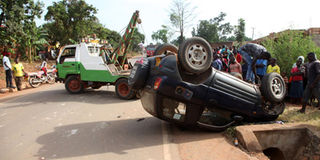Play a part in reducing road accidents

When you are driving, you should be doing just that and nothing else. In case of an accident, do not touch or move the seriously wounded victims unless there is a risk of fire or toxic fumes. FILE PHOTO
What you need to know:
- Leonard Alikiriza, the chief executive officer Nyaks and Lenny Enterprises, a company that transports cement, says the employer can ensure that workers have the prerequisites for safe road travel by providing training.
- Accident and near miss reports provide information regarding places in which dangers exist.
Many Families have chilling accounts of losing their loved ones to road accidents. More than half of road fatalities involve people inside motor vehicles, the rest are either pedestrians, cyclists or motorcyclists.
Human error is often seen as the cause of road accidents. However, the traffic environment must be developed in such a way that human errors do not lead to serious consequences. Improving road safety involves dealing with issues related to road users, the traffic environment, and the condition of vehicles.
Training for drivers especially on safe driving, first aid, loading of vehicles, how to report accidents and near misses on the road, should also be paramount
Weather and visibility
According to Benjamin Ochola, a traffic officer, changes in weather conditions can alter the road surface, which can increase the risk of skidding, thus increasing the distance needed to stop a vehicle. Inadequate visibility is a risk factor.
This can be due to the weather, darkness, and covered or broken vehicle windows, lack of lights or reflectors. Other visibility risks are road users’ changed or weakened eyesight. Enough street lighting and encouraging pedestrians or cyclists to wear reflective clothing increases their visibility, thus increasing their safety on the road.
Health
According to Dr Charles Wabwire, a private Orthopedic doctor, drivers face the risk of developing musculoskeletal disorders of the neck, shoulders and back.
Professional drivers are also exposed to vibration produced by the vehicle. Whole body vibration and prolonged sitting or standing increase the risk of developing musculoskeletal disorders (especially back disorders).
“Ergonomics, such as the design of the seat and other equipment should be considered, and appropriate advice on driving posture should be provided,” Ochola says. Employers must ensure that people who drive for work are aware that they must meet the minimum legal eyesight standards and encourage them to have their sight tested regularly,” he says.
Safety devices and aspects
The technical condition of vehicles is important. Drivers should use vehicles that are equipped with safety devices including airbags, speed alerts and adaptive headlight systems, among others.
“Wearing a helmet decreases the risk of head injuries while cycling, roller-skating or riding a motorcycle,” the doctor advises. In addition to regular general checks, drivers should know how to check the condition of their vehicle before starting a journey. If the vehicle is damaged or fails the check, the driver should have repairs done before setting off. Similarly, tyres, especially when braking must meet safety requirements. They should be checked before driving and replaced by new ones if there are signs of wear.
Proper loading
In order to avoid accidents caused by shifting materials, fix the load in such a way that it will not be shed, even in sudden braking situations. The weight of the load should not exceed the capacity of the vehicle.
Risk assessment
Leonard Alikiriza, the chief executive officer Nyaks and Lenny Enterprises, a company that transports cement, says the employer can ensure that workers have the prerequisites for safe road travel by providing training.
“Training increases drivers’ awareness of risks. Different vehicle types demand different training, but traffic regulations are the same for all road users. It is important that all road users know and adhere to traffic regulations,” he says.
Alikiriza says in addition to general road accident risks, professional drivers face risks caused by organisational stressors such as just-in-time management and client pressure. “Employers can improve work-time road safety by allowing working time flexibility and change of shifts,” he says.
Driving under the influence
Driving under the influence of alcohol or drugs poses a serious risk not only to the driver, but also to passengers and other road users. Alcohol and drugs impair judgement, making drivers more likely to take risks. Substance abuse slows reactions, increases stopping distances, affects judgement of speed and distance, and reduces the field of vision.
Investigating road accidents
Accident and near miss reports provide information regarding places in which dangers exist. Inadequate maintenance of roads and road surfaces may lead to road accidents. Drivers can improve their road safety by collecting reports on places that pose particular risks to commuters and professional drivers, and by investigating road accidents and afterwards providing feedback and safety suggestions to those responsible for the traffic environment.
Others
•Drivers should avoid being involved in complex conversations while driving.
• Most roads are designed with particular speed limits beyond which you should not drive.
• When someone neglects to obey traffic signs and signals, they are putting themselves and others at risk.




